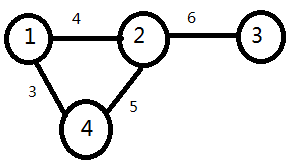【算法简述】图论专题:最短路
图论问题概述总结 对于**图论**,我们尊熟悉的算法是比较多的,这次,我就找了集中常用的算法。 ## 几种算法 1. **最短路**算法(Dijkstra,SPFE,FLOYD) - Dijkstra单源最短算法 首先,此算法适用于计算一个点到另一个点的最短路径,且算法绝对不能出现负环。这个算法的速度慢,只用于接觉小规模的问题,如图: 这个图就是求算法的基本思路。算法过程: - 从节点上找到最近点那个节点,将他标记,加入集合U。 - 将定点U连出边的邻点相连接,不在集合U中寻找。 - 重复前面的操作,用来指导V=U是,查找结束,最后结束流程。 本算法的算法流程图: https://wenku.baidu.com/view/8a5c11303968011ca300916a.html 参考代码: ``` #include <iostream> #include <cstring> using namespace std; const int N = 1e3 + 9; const int M = 1e4 + 9; const int inf = 0x3f3f3f3f; struct edge { int v, w, next; edge() {} edge(int